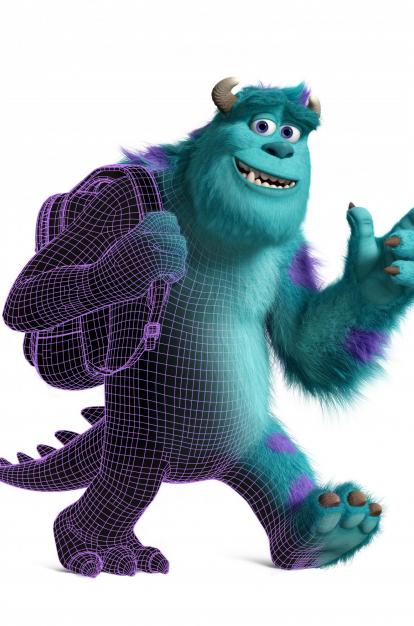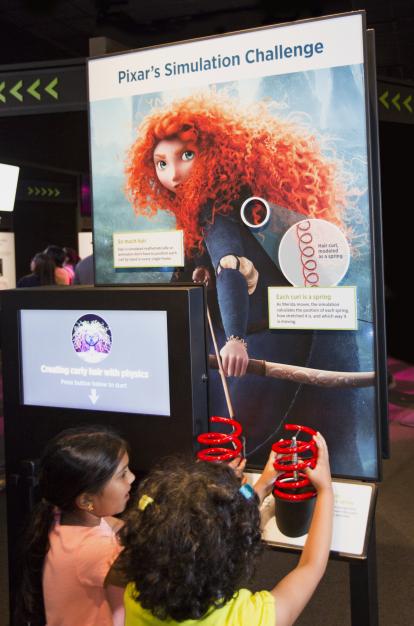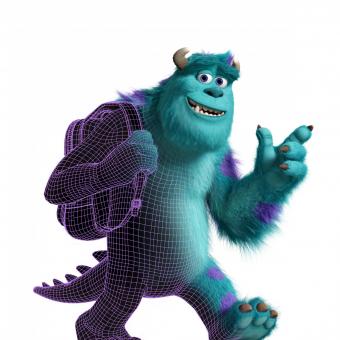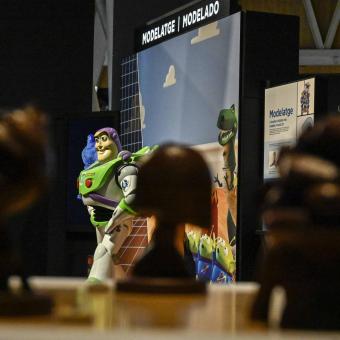
Available resources
Pixar's animated films are full of details. Here you can read curiosities about how some of their most mythical characters or scenes were created.
Modeling
- The opening race contained 60,000 seated cars and an additional 700 cars in the infield & aisles. The final race had 100,000 seated cars, plus an additional nearly 1500 cars in the infield and aisles. There are nearly 13,000 cars entering the Final Race stadium to find seats. (Cars)
- 90% of all the monsters in Monsters, Inc. have Mike's tongue. (Monsters, Inc.)
Rigging

- There are 202 teeth in Bruce's mouth, each individually animatable. (Finding Nemo)
- To save on time during Ratatouille, the artists at Pixar skipped one detail - none of the human characters have any toes. (Ratatouille)
Surfaces
- To develop the desired look for Queen Elinor’s emerald dress in the film, the art department took actual matte silk fabric samples and painted metallic colors onto the fabric, adding other subtle embellishments. Shading artists then replicated the look in the computer. (Brave)
- Lighting McQueen has 14 different paint variants, ranging from subtly different amounts of dirt and dust to the completely new paint jobs near the end of the film. (Cars)
- The nearly 35,000 texture maps in Toy Story 2 occupy nearly 40 GB of disk space. There are more than 10,000 texture maps for the humans alone. (Toy Story 2)
- It took over a month to digitally paint Al's car. (Toy Story 2)
Sets and Cameras
- All of the bedroom doors in the Door Vault in Monsters, Inc. were created from different combinations of 26 paint colors, 12 styles, 8 wood colors, 10 decals and 6 door knobs, and 3 hardware types. (Monsters, Inc.)
- For Ratatouille, Pixar filmmakers created over 270 pieces of food in the computer. Every food item was prepared and styled in a real kitchen, then photographed for reference and eaten. (Ratatouille)
- There are roughly 1000 unique props in the interior of WALL•E's truck. It took a team of five modelers and five shading artists more than a month to create them all. (WALL•E)
- No Pixar film before Brave has had a castle in it, so the DunBroch castle had to be designed from the ground up, inside and out. Everything from the architecture of the structure itself to the tapestries in the hall and the moss on the stone walls was designed and built as 3D models in the computer. The production team visited, researched and studied a number of castles for reference. (Brave)
Animation
- During the production of Up, each animator produced an average of 4 seconds of animation a week. (Up)
- The most animation produced in one week of production on Toy Story 2 was 5 minutes and 42 seconds. (Toy Story 2)
- A Technical Director hand animated the hairs on Sulley’s fingers to make them react to Boo's touch near the end of the movie. (Monsters, Inc)
Simulation

- Sulley has 25,336 "key" hairs, which are used to guide the motion and shape of the other 2.3 million hairs. (Monsters, Inc)
- Merida has more than 1500 individually sculpted, curly red strands that generate about 111,700 total hairs. (Brave)
Lighting
- There are a total of 21,566 lights in four different shots when Lighting McQueen and Mack first get on the road to California. (Cars)
Rendering
- Monsters University took 100 million CPU hours to render, which is equivalent to 10,000 years for a single computer. (Monsters University)
- It took almost two weeks to render the most complicated shot on The Incredibles. (The Incredibles)
Latest Update: 07 May 2024 | 11:15

